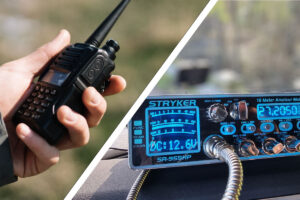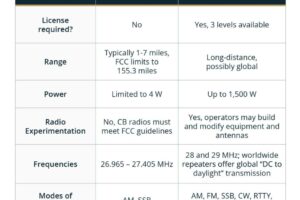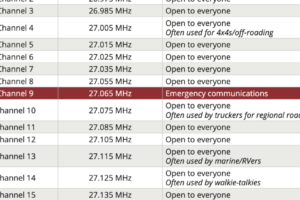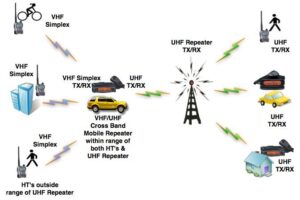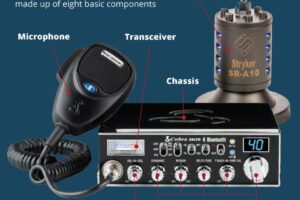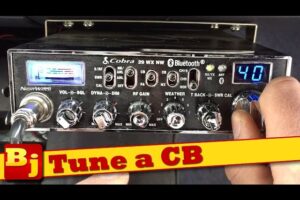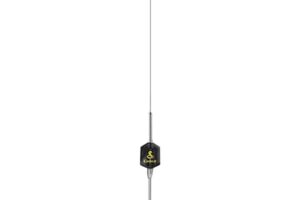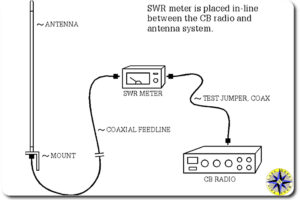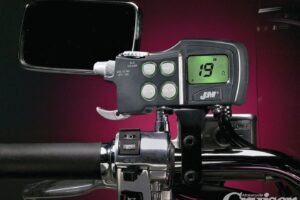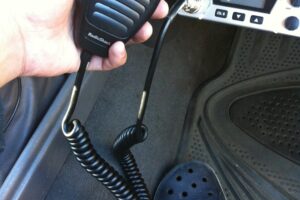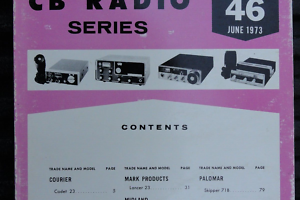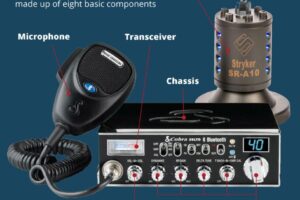Difference Between CB Radio and 2 Way Radio: Ultimate Guide
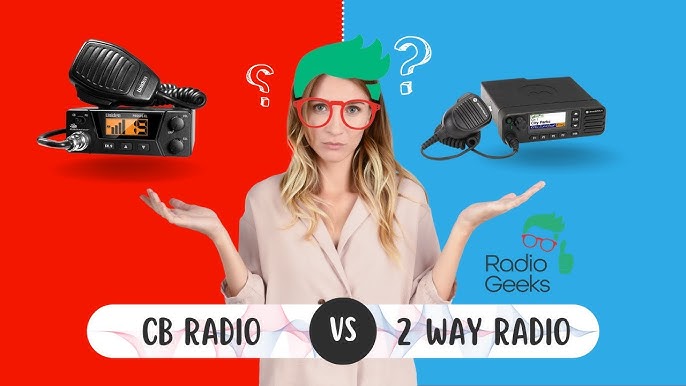
Citizens Band (CB) radios and two-way radios might seem similar. Both allow for communication over certain distances.
Yet, they have significant differences that are crucial to understand. Understanding the distinction between CB radios and two-way radios can help you make better choices. CB radios are often used by truckers and hobbyists. They operate on specific frequencies and are easy to use.
Two-way radios, on the other hand, have a broader range of applications. They are used in various industries, including security, construction, and event management. Knowing how each type works and their best uses can save you time and money. Let’s explore the key differences to see which suits your needs best.

Credit: midlandusa.com
Historical Background
Understanding the historical background of CB radios and 2-way radios offers insight into their distinct evolution. Both technologies have rich histories, shaping communication in different ways.
Origins Of Cb Radio
CB radio, or Citizens Band radio, began in the 1940s. The Federal Communications Commission (FCC) created it for personal use. Truckers and hobbyists were among the first users. CB radios became very popular in the 1970s. This was due to their use in movies and TV shows. They allowed long-distance communication on the road. Anyone could use a CB radio without a license. This made them accessible to the general public.
Development Of 2 Way Radio
2-way radios have roots in the early 20th century. They were initially used by the military. The first 2-way radios were large and required a power source. Over time, they became smaller and more portable. By the 1940s, police and emergency services started using them. These radios allowed instant communication over short distances. They were crucial for coordination in critical situations. Today, 2-way radios are used in various fields like security and events.
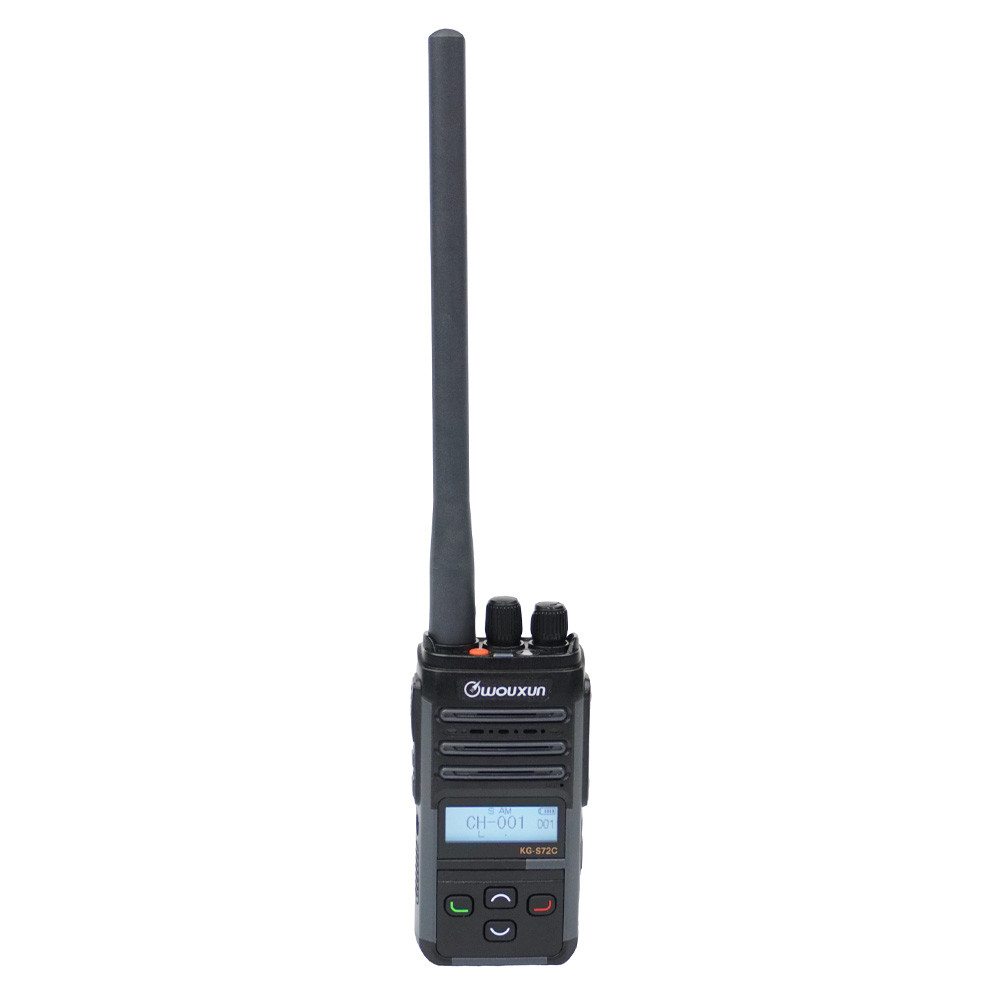
Credit: www.buytwowayradios.com
Technical Specifications
Discover the key differences between CB radios and 2-way radios. CB radios operate on 40 channels, ideal for long-distance communication. 2-way radios offer multiple frequencies, suitable for local communication, ensuring reliable connectivity for various uses.
Technical Specifications play a crucial role in understanding the differences between CB Radio and 2 Way Radio. They determine how each device operates, its range, and overall performance. Let’s dive into the specifics of frequency ranges and power output to help you make an informed decision.
Frequency Ranges
CB Radios operate on frequencies between 26.965 MHz to 27.405 MHz. These frequencies are part of the 11-meter band. This narrow range allows for communication over short distances, typically within 3 to 20 miles.
On the other hand, 2 Way Radios use a broader range of frequencies. They can operate on VHF (Very High Frequency) from 136 MHz to 174 MHz or UHF (Ultra High Frequency) from 400 MHz to 512 MHz. This versatility means you can communicate over longer distances, even up to several hundred miles depending on the terrain and conditions.
Have you ever been on a road trip and wished you could communicate with other drivers over a long distance? With a 2 Way Radio, you can do just that due to its extensive frequency range.
Power Output
CB Radios typically have a power output of 4 watts. This is sufficient for basic communication over shorter distances. However, it may not be enough if you are in a remote area or facing obstacles like hills and buildings.
Conversely, 2 Way Radios can have power outputs ranging from 0.5 watts to 5 watts for handheld devices, and up to 50 watts or more for mobile units. Higher power output means stronger signals and greater communication range. Imagine being able to stay in touch with your team during a hiking trip in the mountains, thanks to the powerful signal of a 2 Way Radio.
Wouldn’t you prefer a radio that can keep you connected even in challenging environments? The higher power output of 2 Way Radios makes them a better choice for reliable communication.
Understanding these technical specifications will help you decide which type of radio suits your needs. Whether you are an outdoor enthusiast, a truck driver, or simply someone who values reliable communication, knowing the frequency ranges and power output can make a big difference in your radio experience.
Usage Scenarios
CB radios are popular among truckers for long-distance communication. 2-way radios are used in close-range activities like hiking. Each serves different communication needs.
When deciding between a CB radio and a 2-way radio, understanding the usage scenarios can help you make an informed choice. Each type of radio has unique applications that cater to different needs. Let’s dive into the common uses of CB radio and the applications of 2-way radio.
Common Uses Of Cb Radio
CB radios are often used by truck drivers. They rely on these radios to communicate about road conditions, traffic jams, and weigh stations. This real-time information helps them plan routes efficiently.
Off-road enthusiasts also favor CB radios. When you’re deep in the wilderness, cell phone signals can be unreliable. CB radios ensure you stay connected with your group, enhancing safety during adventures.
Lastly, CB radios are popular for personal communication in rural areas. These regions might lack reliable cell coverage, making CB radios a practical choice for staying in touch with neighbors.
Applications Of 2 Way Radio
2-way radios shine in professional settings. Construction workers use them to coordinate tasks across large sites. The instant communication ensures projects run smoothly and safely.
Event organizers also benefit from 2-way radios. Managing a large crowd requires quick and clear communication among staff. These radios help maintain order and address any issues promptly.
In educational institutions, 2-way radios are essential for security teams. They allow for immediate response to emergencies, ensuring the safety of students and staff.
Have you ever thought about the specific needs your situation demands? Understanding these scenarios can guide you to the right choice between CB and 2-way radios.
Licensing Requirements
When choosing between a CB radio and a 2-way radio, understanding licensing requirements is crucial. These requirements can affect how you use your radio and the costs involved. Whether you’re an enthusiast or need a radio for professional use, knowing these rules can save you headaches and fines.
Cb Radio Licensing
CB radios offer a hassle-free experience with no licensing required. This makes them an attractive option for hobbyists and casual users. You can purchase a CB radio, set it up, and start communicating without dealing with paperwork.
In the U.S., the FCC regulates CB radio usage but does not require a license. This convenience allows people to connect easily, especially useful in remote areas. However, there are restrictions, like a power limit of 4 watts, which you must adhere to.
Have you ever been on a road trip and wished you could chat with other drivers? CB radios let you do just that, all without needing to fill out a single form.
2 Way Radio Licensing
Unlike CB radios, most 2-way radios require a license. These radios often operate on specific frequencies that need regulation. Licensing ensures these frequencies are used correctly and efficiently.
The licensing process can vary based on your location and intended use. For instance, in the U.S., you might need to apply for a license through the FCC. This process can involve paperwork, fees, and waiting periods.
Picture this: You’re running a business and need reliable communication between team members. A licensed 2-way radio provides clearer signals and dedicated channels, making your operations smoother.
Have you considered how licensing can impact your radio choice? Weighing the ease of CB radios against the robust features of licensed 2-way radios can guide your decision.
Range And Coverage
The range and coverage of communication devices are crucial for their effectiveness. Understanding how CB radios and 2-way radios differ in this aspect can help users make informed decisions. Each type of radio has unique characteristics that influence how far their signals can travel and how reliable they are in different environments.
Cb Radio Range
CB radios operate on 27 MHz frequency, offering moderate range. Generally, they reach up to 4 miles under optimal conditions. This range can vary due to terrain, weather, and obstacles. CB radios are popular among truckers for highway communication. They work best in open areas without many obstructions. In cities, tall buildings can limit their effectiveness. Antenna quality also impacts the range greatly. Longer antennas usually enhance signal reach.
2 Way Radio Coverage
2-way radios often use higher frequencies such as UHF and VHF. These frequencies provide better coverage, particularly in urban settings. They can cover distances from 1 to 20 miles, depending on the model and environment. Buildings and trees can affect coverage, but UHF signals penetrate barriers better than VHF. Many industries rely on 2-way radios for reliable communication. They’re essential in construction, security, and event management. Repeater systems can extend their range significantly.
Equipment And Accessories
When choosing between a CB radio and a 2 way radio, understanding the equipment and accessories required for each can help you make an informed decision. While both types of radios serve the purpose of communication, the gear and add-ons differ significantly. Let’s dive into what each setup entails.
Cb Radio Gear
CB radios come with a variety of equipment that is essential for optimal performance. The primary component is the CB radio unit itself, which can be a handheld model or a mobile unit mounted in your vehicle. You’ll also need an antenna, which is crucial for signal strength and range. Magnetic mount antennas are popular for mobile units, while base stations might require a larger, fixed antenna.
Microphones are another key accessory. Many CB radios come with a standard mic, but you can upgrade to a noise-canceling microphone for clearer communication. Additionally, a SWR meter is useful for tuning your antenna, ensuring you get the best possible signal.
Power supplies and mounts also play a significant role. Handheld CB radios typically use batteries, while mobile units connect to your vehicle’s power. Mounting brackets and dash mounts help secure the radio in place, making it easier to use while driving.
2 Way Radio Accessories
2 way radios, often referred to as walkie-talkies, also have their own set of accessories. Unlike CB radios, 2 way radios are typically more compact and portable. The primary accessory for these radios is the earpiece or headset, which allows for hands-free operation and discreet communication.
Another common accessory is the belt clip or holster, which makes it easy to carry the radio around. Battery packs and chargers are essential, especially if you rely on the radio for extended periods. Some models offer rechargeable battery packs, while others use standard AA or AAA batteries.
For enhanced communication, you might consider adding a speaker mic, which combines a speaker and microphone into one unit, allowing you to communicate without holding the radio. Protective cases and weatherproof covers are also useful for keeping your radio safe in harsh conditions.
When deciding between a CB radio and a 2 way radio, think about the specific gear and accessories you’ll need. Do you prefer the robust setup of a CB radio with its powerful antenna and mounted unit? Or do you value the portability and convenience of a 2 way radio with its handy earpieces and belt clips? Your choice will depend on how and where you plan to use these communication tools.
Pros And Cons
Understanding the pros and cons of CB radio and 2 way radio can help you decide which one suits your needs. Both have unique features and limitations. Let’s dive into the advantages and drawbacks of each.
Advantages Of Cb Radio
CB radios are easy to use. They require no license. You can start communicating right away. CB radios have a long history. Many truckers and hobbyists use them. They cover a wide range of frequencies. This allows for multiple channels. CB radios are affordable. You can find them at low prices.
Disadvantages Of Cb Radio
CB radios have limited range. They work best for short distances. Interference can be a problem. Many users share the same channels. This can cause noise. CB radios have fewer privacy options. Anyone can listen to your conversations. They also have limited features. Modern communication tools offer more functions.
Benefits Of 2 Way Radio
2 way radios offer better range. They can cover long distances. They provide clear communication. 2 way radios have more channels. This reduces interference. They have privacy features. You can use secure channels. 2 way radios are reliable. They work well in emergencies. They have advanced features. GPS and text messaging are common.
Drawbacks Of 2 Way Radio
2 way radios can be expensive. Advanced models cost more. They may require a license. This adds to the cost. They are complex. Some users find them hard to operate. 2 way radios are larger. They can be bulky to carry. Battery life can be a concern. Some models need frequent charging.
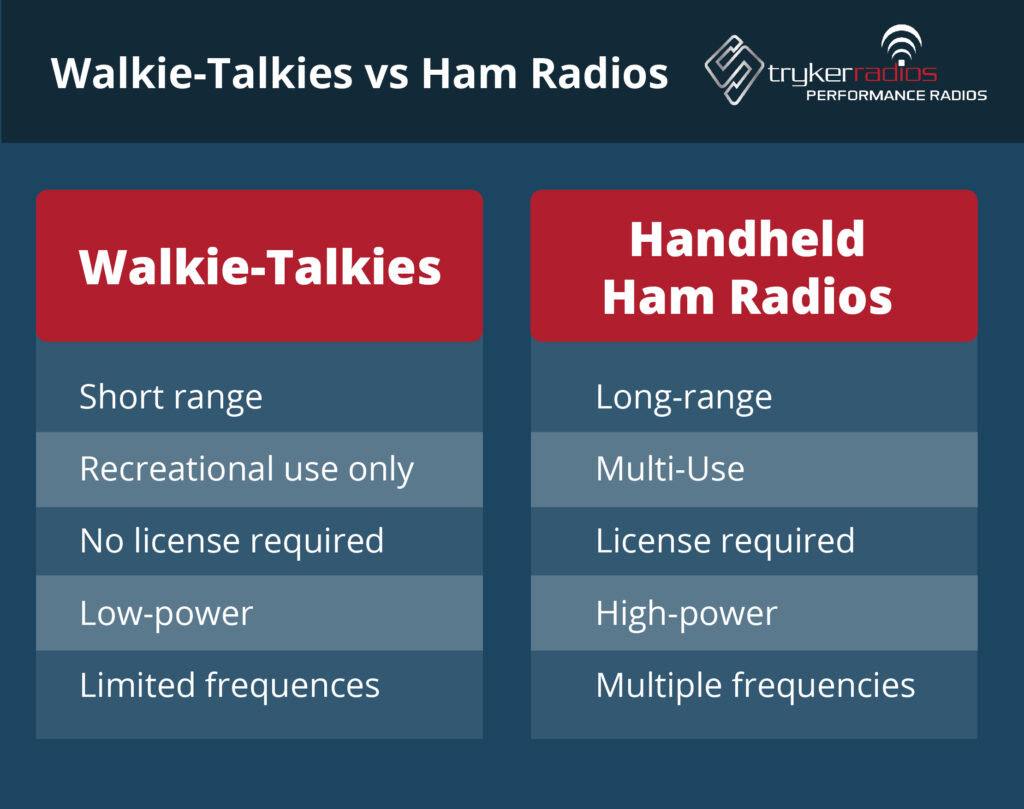
Credit: strykerradios.com
Frequently Asked Questions
What Is The Main Difference Between Cb Radio And 2-way Radio?
CB radios operate on 40 channels in the 27 MHz band. 2-way radios can operate on various frequencies and bands, offering more flexibility.
Can Cb Radios Communicate With 2-way Radios?
No, CB radios and 2-way radios use different frequencies. They cannot directly communicate with each other.
Which Is Better For Long-distance Communication?
2-way radios are better for long-distance communication. They often use repeaters to extend their range beyond CB radios.
Are Cb Radios Still Popular?
Yes, CB radios remain popular among truckers and hobbyists. They are useful for short-range communication.
Conclusion
Choosing between a CB radio and a 2-way radio depends on your needs. CB radios are ideal for long-distance communication on the road. They work well for truck drivers and travelers. Meanwhile, 2-way radios suit short-range communication. Perfect for outdoor adventures and team activities.
Both have unique features. Consider range, channels, and purpose. Always check your specific requirements before buying. Understanding these differences helps in making the right choice. Ensure effective and reliable communication with the right device.

